Installing SETS 6000 on Windows 8 and Windows 10 using Hyper-V
If your Windows 8/8.1 or 10 does not include Hyper-V, then you won’t be able to do this tutorial. You can still create an XP virtual machine using VMWare Player or VirtualBox.
Support for Windows XP has ended, and, although unofficial service packs exist, a better and safer idea would be to run XP as a virtual machine under your current OS if you still need to do some testing under XP. If you have an XP Setup ISO or an XP installation disc, creating a virtual machine running XP is much easier, but if you don’t, you can follow the tutorial below to install XP Mode under Windows 10. It works for Windows 8/8.1 Pro as well.
Check Hyper-V hardware compatibility by opening up PowerShell or Command Prompt (cmd.exe) and entering systeminfo.exe. It should list, under Hyper-V Requirements:
- VM Monitor Mode Extensions: Yes
- Virtualization Enabled In Firmware: Yes
- Second Level Address Translation: Yes
- Data Execution Prevention Available: Yes
1. By default, Windows 10, just as Windows 8 did, comes with a few features disabled, including the Hyper-V technology.
Installing SETS 6000 on Windows 8 using Hyper-V
2. In Windows 8 in order to enable Hyper-V, you need to go to Win+X (opens the power user menu) -> Control Panel -> Programs -> Turn Windows features on or off, under Programs and Features. Alternatively, you can open the Run command (Win+R) or do a search (Win+S) and enter optional features, then hit Enter. This will open a new window where you must tick the box near Hyper-V, as shown in the image below, then click on OK button.
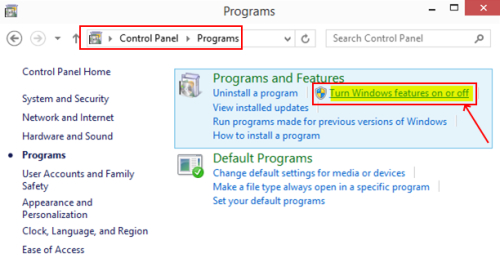
3. You will be prompted to restart. Do so. Upon re-entering Windows, Hyper-V will be enabled. The image below shows the Hyper-V options under Windows 8.1 – it looks similar in Windows 10.
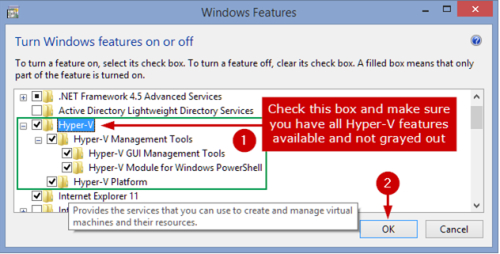
4. If some of your Hyper-V options are grayed out, you should restart, enter BIOS and enable virtualization there first. BIOS menus are different from manufacturer to manufacturer, so you should search for settings regarding Virtualization, Data Execution Prevention (DEP), and SLAT. Enable them and restart.
5. If you don’t see Hyper-V Platform or it appears grayed out in the ‘Windows Features’ window above, then you won’t be able to create a virtual machine using Hyper-V.
6. Go to 7-zip.org web page, download and install the 7 Zip program in your PC. It’s important to install the 32-bit (also called x86) version of 7-zip for a 32-bit operating system and the 64-bit (also called x64) version for a 64-bit OS, since the x64 version won’t work on x86 and the x86 version won’t run with context menu on x64 machines. If you are not sure if you have a x86 or x64 operating system installed, you can find this out in several ways. Here are 2: a) Press Win+X (this opens the Power User Menu) and select System. Look under System -> System type for the OS type you have installed or b) Click Start (or press the Win key) and type PC Info. Look under System type and find out the type of OS you’re running. Now that you know what type of OS you have installed, download and install the corresponding version of 7-zip.
7. Right-click with mouse the WindowsXPMode_en-us.exe file downloaded before and select 7-zip -> Extract Here or Extract to “WindowsXPMode_en-us” (or the filename you downloaded)
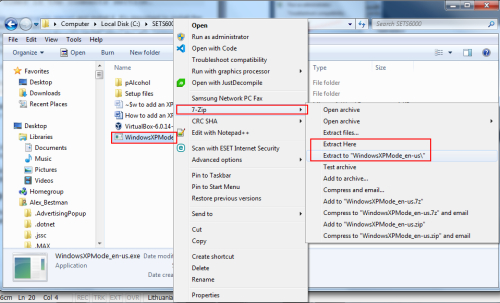
8. After extraction browse to Sources folder and notice the xpm file. Right-click with mouse on xpm and choose 7-zip -> Open archive. If you don’t see the Sources folder at this time, go back one step and from the same 7-zip right-click context menu, choose open archive as CAB, instead of extracting to “WindowsXPMode_en-us”, then pick up from there.
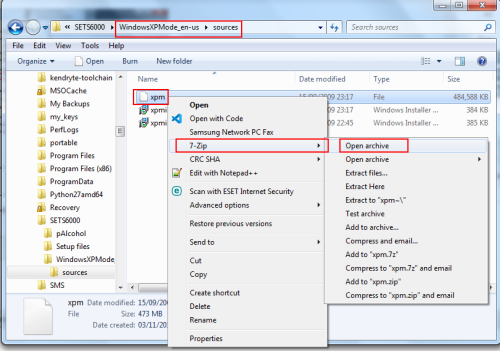
9. Notice the VirtualXPVHD file.
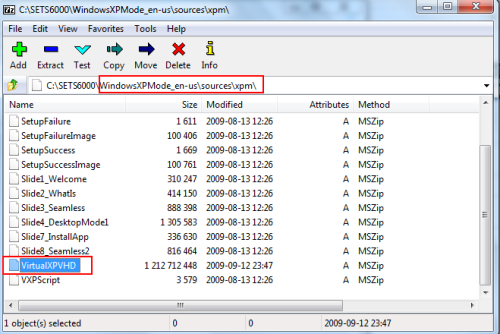
10. Extract it to a location of your choice. Rename it to VirtualXPVHD.vhd.
11. You can go ahead and delete the WindowsXPMode_en-us.exe file downloaded and all the other files extracted from it, except for VirtualXPVHD.vhd.
12. Open Hyper-V Manager by clicking on Start (or press the Win key) and type Hyper-V Manager, then Enter. Alternatively, you can open Start or Run (Win+R) and type Virtmgmt.msc, then Enter.
13. Make sure your local virtualization server is selected.
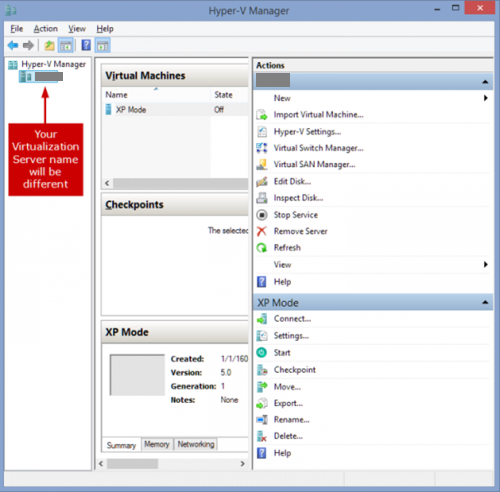
If the left pane shows no Hyper-V servers (your local host computer) to connect to, then select the Hyper-V Manager in the left pane, click on Connect to server on the right pane, select Local computer in the dialog that follows and click on OK. Optional: if you need an internet connection for your virtual machine, you need to setup a virtual switch by going to Action -> Virtual Switch Manager, in the Hyper-V Manager window. Here you can create an External Virtual Switch, linked to your physical network card. Make sure the box Allow management operating system to share this network adapter is checked.
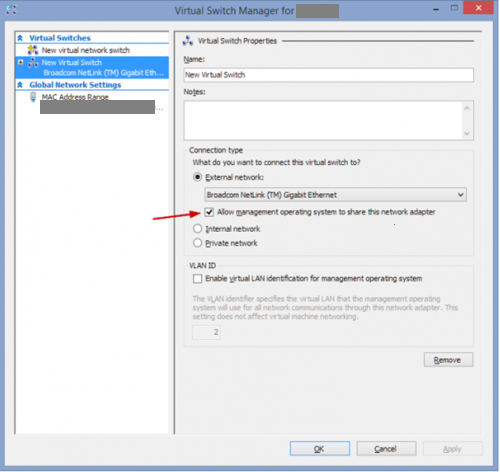
This default type of network connection does not work for XP and Vista.
14. Click on Action -> New -> Virtual Machine. This will open an wizard.
15. Click on Next button and, in the next window, specify a name for your server.
16. In the next window, select Generation 1. (Generation 2 is only used for Windows 8 64-bit or newer and Windows Server 2012 or newer guest operating systems).
17. Specify an amount of RAM in the next window. 512 MB or 1024 MB should do it.
18. In the next window you can configure networking. If you don’t need internet for your XP VM, click on Next button.
19. Select Use an existing virtual hard disk and browse for the VirtualXPVHD.vhd file. The Location path will vary in your case.
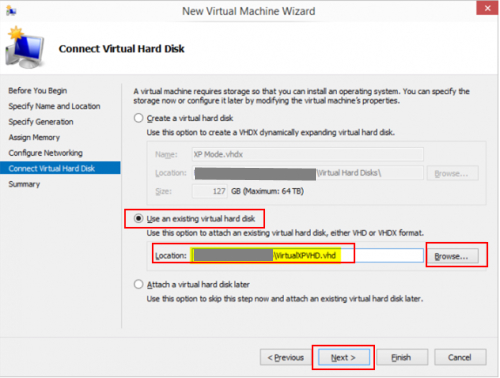
20. Click on Next button for Summary, then click on Finish button. Your XP Virtual Machine is now created.
21. You need to connect to your newly created XP virtual machine and start it. Click on Connect under your XP VM, in the right Actions column or in the new window that opens, click on green Start button.
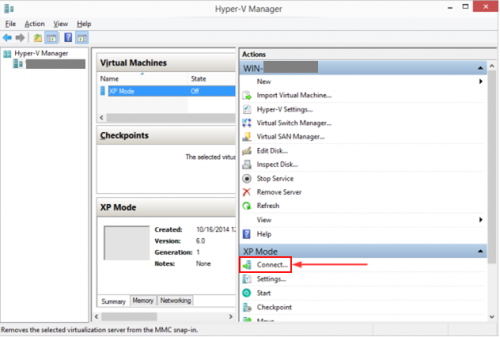
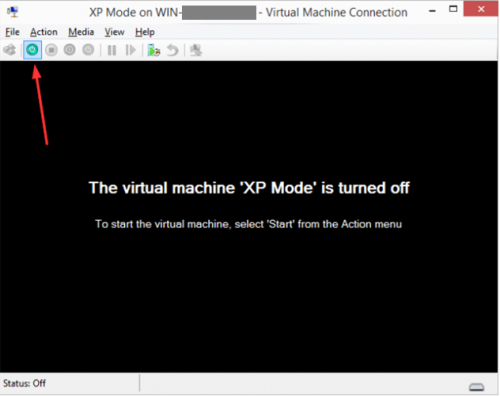
22. The first time you start the VM, it will do the last steps of a regular XP installation. It won’t go through the full XP installation, but you’ll still need to agree to Terms, pick a computer name, set time and date, language and, after a final reboot, it will prompt you to configure updates.
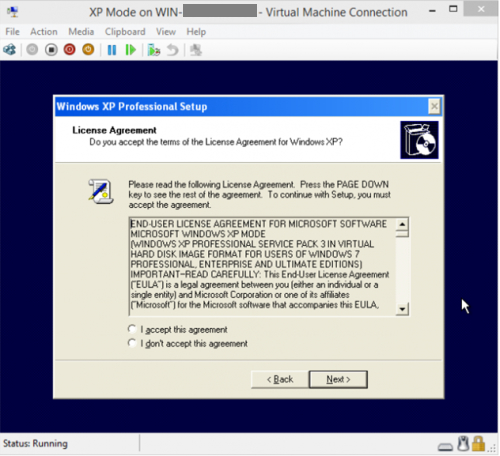
23. If everything went well, you should have a working XP Virtual Machine inside your Windows 8 now.
24. When installation done you will see the Windows XP desktop.

25. Go to Google drive and download the SETS6000.rar with SET6000 program files. The archive file size is 191 MB.
26. Unzip the folder SETS 6000 from SETS6000.rar to your PC. You will find subfolder SETS 6000 inside with three files – SETS6k_Disk1.mdf, SETS6k_Disk1.mds and KEY.txt. In order to mount your disk image use file SETS6k_Disk1.mdf.
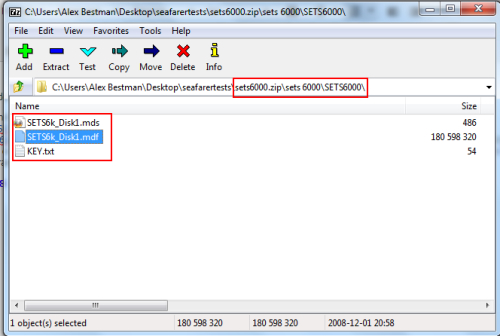
27. Unzip and install UltraISO program. Open UltraISO program, click on Continue to Try button if this program is not registered.
28. Click on Mount to Virtual Drive icon (shown with red arrow).
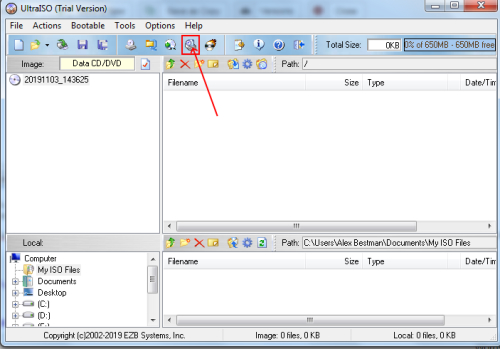
29. Select the image file SETS6k_Disk1.mdf and click on Mount button. If you want to unmount image file from virtual drive click on Unmount button.
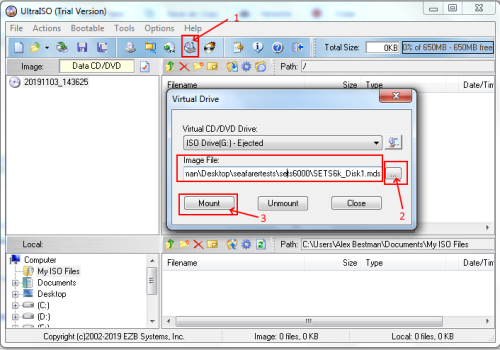
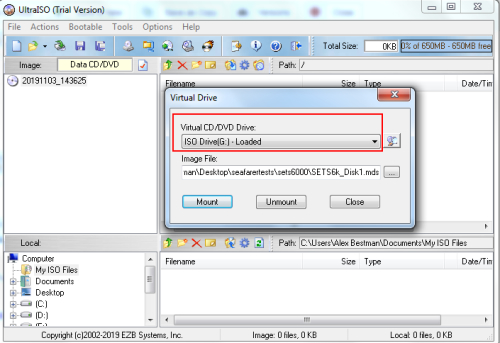
30. Your image file is loaded on Virtual Drive now. As you can see we have the virtual (G) drive with image file.
31. Go to My Computer and you will see the Virtual Drive with SETS6k_Disk1.mdf image.
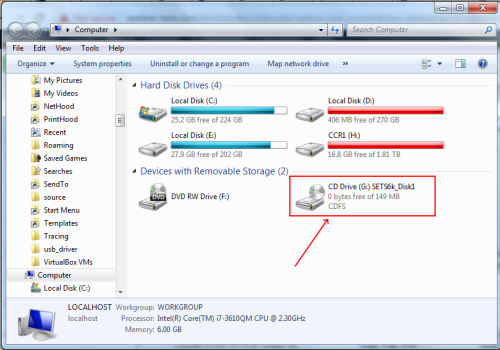
32. Go back to Oracle VM VirtualBox window. Go to Devices -> Optical Drives and make sure that Host drive (G) selected.
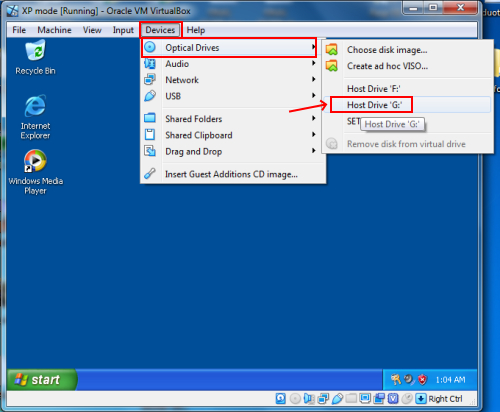
33. You will see pop-up window with three grey buttons – SETS 6000 WorkStation , SETS 6000 Reports , SETS 6000 Data Files
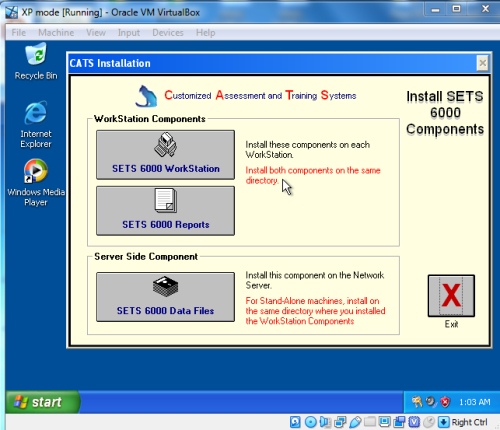
34. Click on SETS 6000 WorkStation button. You will need to click on Next button till the installation starts (5 times). If you will get any errors just agree with them – click on OK button.
35. When the first part has been installed click on SETS 6000 Reports button. You will need to click on Next button till the installation starts (4 times). Then click on Finish button. The second part installation completed.
36. If the system is asking to restart PC click on OK button and restart your PC. After reboot go to virtual drive and double-click on RunCopy.exe to continue with installation.
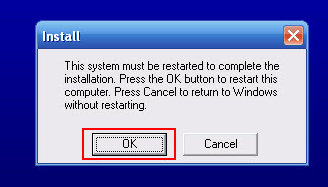
37. Click on SETS 6000 Data Files button. You will need to click on Next button till the installation starts (5 times). Then click on Finish button. The last part installation completed.
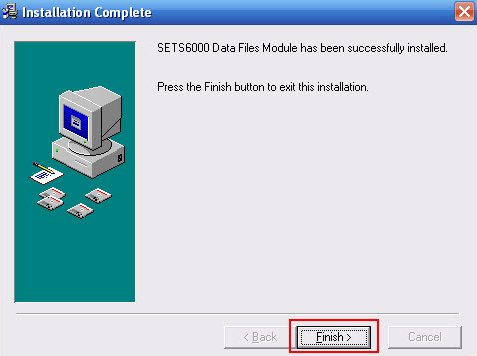
38. Click on Exit button.
39. Find on your desktop SETS6000 shortcut and double-click on it.

40. You will see the Reminder pop-up window with timer of 10 seconds.
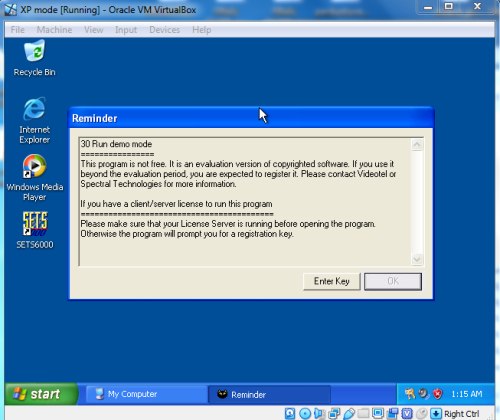
41. Wait untill OK button will be active.
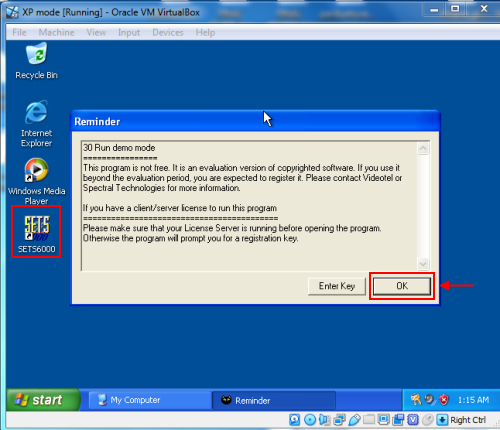
42. Click on OK button and you will see a new pop-up window.
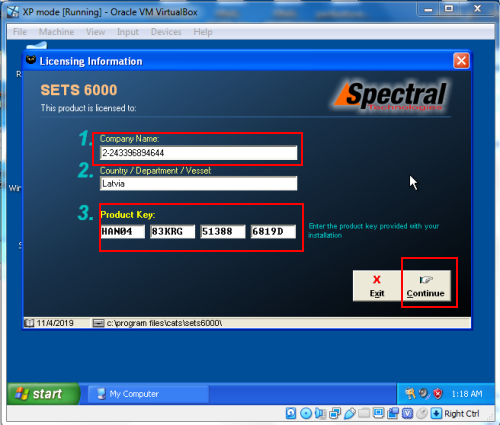
43. Type the company name (2-2403396894644), country / department / vessel (any information) and product key (HAN04-83KRG-51388-6819D)
44. Click on Continue button. You will see pop-up window.
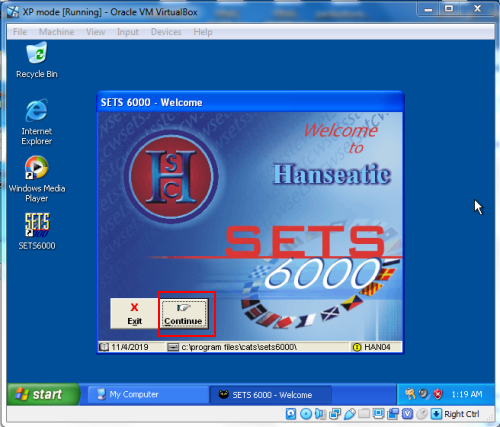
45. Click on Continue button.
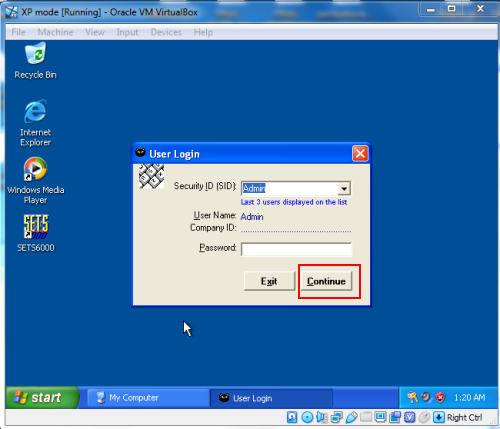
46. You do not need to type the password, just click on Continue button. That’s it. You can access Tutorial tests now.
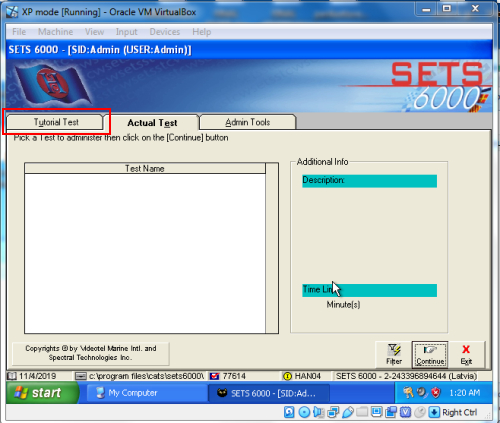

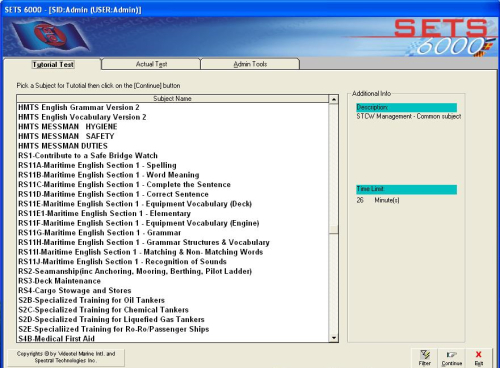
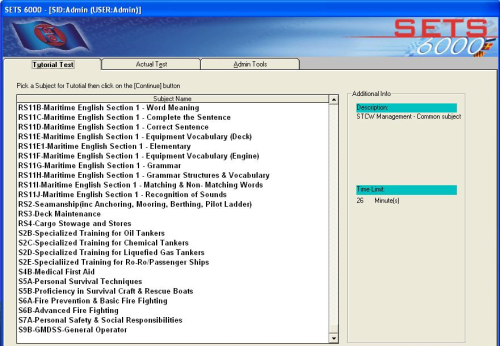
Installing SETS 6000 on Windows 10 using Hyper-V
Hyper-V can be enabled in many ways including using the Windows 10 control panel, PowerShell or using the Deployment Imaging Servicing and Management tool (DISM).
Hyper-V is built into Windows as an optional feature – there is no Hyper-V download. This article walks through each option.
Check Requirements:
- Windows 10 Enterprise, Pro, or Education
- 64-bit Processor with Second Level Address Translation (SLAT).
- CPU support for VM Monitor Mode Extension (VT-c on Intel CPUs).
- Minimum of 4 GB memory.
The Hyper-V role cannot be installed on Windows 10 Home.
1. First option. Enable Hyper-V using PowerShell. Open a PowerShell console as Administrator. Run the following command:
Enable-WindowsOptionalFeature -Online -FeatureName Microsoft-Hyper-V -All
If the command couldn’t be found, make sure you’re running PowerShell as Administrator. When the installation has completed, reboot your PC.
2. Second option. Enable Hyper-V with CMD and DISM. The Deployment Image Servicing and Management tool (DISM) helps configure Windows and Windows images. Among its many applications, DISM can enable Windows features while the operating system is running. To enable the Hyper-V role using DISM – open up a PowerShell or CMD session as Administrator; type the following command: DISM /Online /Enable-Feature /All /FeatureName:Microsoft-Hyper-V
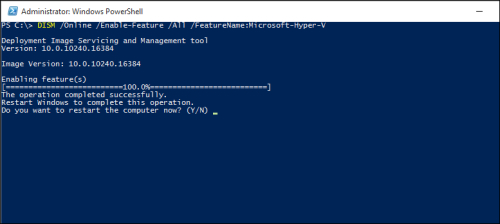
3. Third option. Enable the Hyper-V role through Settings.
3.1 Right click on the Windows button and select Apps and Features.
3.2 Select Programs and Features on the right under related settings.
3.3 Select Turn Windows Features on or off.
3.4 Select Hyper-V and click on OK button.

3.5 When the installation has completed you are prompted to restart your computer.
4. Go to 7-zip.org web page, download and install the 7 Zip program in your PC. It’s important to install the 32-bit (also called x86) version of 7-zip for a 32-bit operating system and the 64-bit (also called x64) version for a 64-bit OS, since the x64 version won’t work on x86 and the x86 version won’t run with context menu on x64 machines. If you are not sure if you have a x86 or x64 operating system installed, you can find this out in several ways. Here are 2: a) Press Win+X (this opens the Power User Menu) and select System. Look under System -> System type for the OS type you have installed or b) Click Start (or press the Win key) and type PC Info. Look under System type and find out the type of OS you’re running. Now that you know what type of OS you have installed, download and install the corresponding version of 7-zip.
5. Right-click with mouse the WindowsXPMode_en-us.exe file downloaded before and select 7-zip -> Extract Here or Extract to “WindowsXPMode_en-us” (or the filename you downloaded)
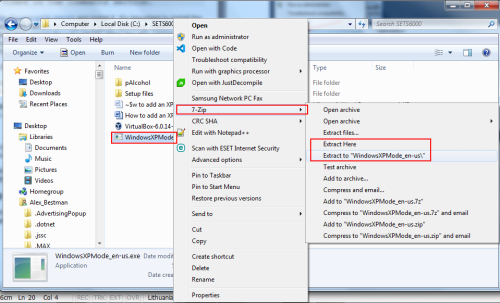
6. After extraction browse to Sources folder and notice the xpm file. Right-click with mouse on xpm and choose 7-zip -> Open archive. If you don’t see the Sources folder at this time, go back one step and from the same 7-zip right-click context menu, choose open archive as CAB, instead of extracting to “WindowsXPMode_en-us”, then pick up from there.
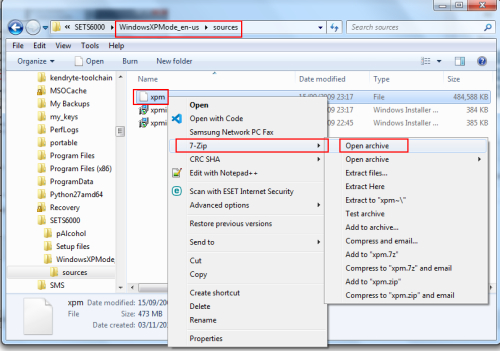
7. Notice the VirtualXPVHD file.
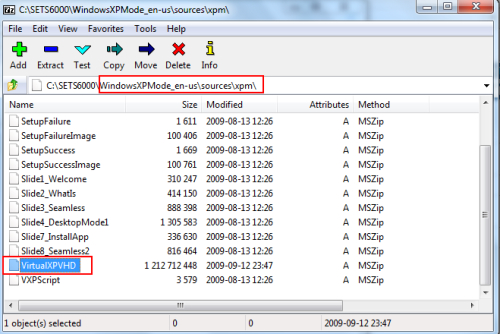
8. Extract it to a location of your choice. Rename it to VirtualXPVHD.vhd.
9. You can go ahead and delete the WindowsXPMode_en-us.exe file downloaded and all the other files extracted from it, except for VirtualXPVHD.vhd.
10. Open Hyper-V Manager by clicking on Start (or press the Win key) and type Hyper-V Manager, then Enter. Alternatively, you can open Start or Run (Win+R) and type Virtmgmt.msc, then Enter.
11. Make sure your local virtualization server is selected.
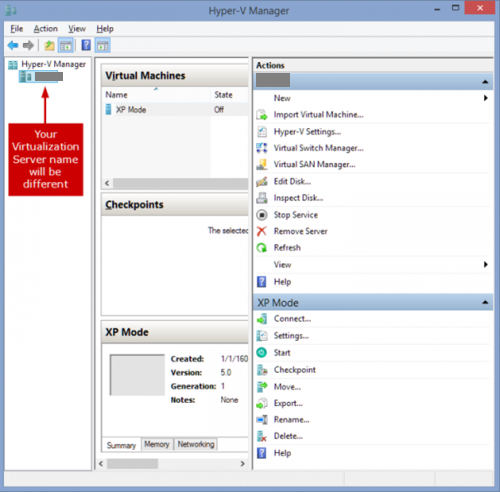
If the left pane shows no Hyper-V servers (your local host computer) to connect to, then select the Hyper-V Manager in the left pane, click on Connect to server on the right pane, select Local computer in the dialog that follows and click on OK. Optional: if you need an internet connection for your virtual machine, you need to setup a virtual switch by going to Action -> Virtual Switch Manager, in the Hyper-V Manager window. Here you can create an External Virtual Switch, linked to your physical network card. Make sure the box Allow management operating system to share this network adapter is checked.

This default type of network connection does not work for XP and Vista.
12. Click on Action -> New -> Virtual Machine. This will open an wizard.
13. Click on Next button and, in the next window, specify a name for your server.
14. In the next window, select Generation 1. (Generation 2 is only used for Windows 8 64-bit or newer and Windows Server 2012 or newer guest operating systems).
15. Specify an amount of RAM in the next window. 512 MB or 1024 MB should do it.
16. In the next window you can configure networking. If you don’t need internet for your XP VM, click on Next button.
17. Select Use an existing virtual hard disk and browse for the VirtualXPVHD.vhd file. The Location path will vary in your case.
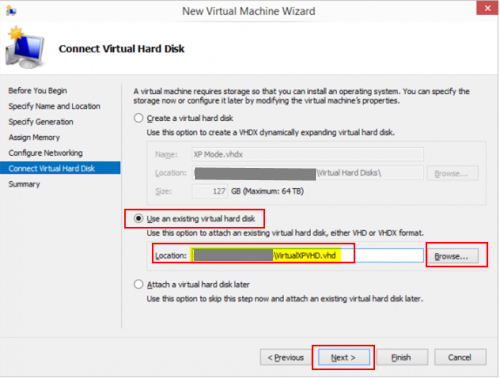
18. Click on Next button for Summary, then click on Finish button. Your XP Virtual Machine is now created.
19. You need to connect to your newly created XP virtual machine and start it. Click on Connect under your XP VM, in the right Actions column or in the new window that opens, click on green Start button.
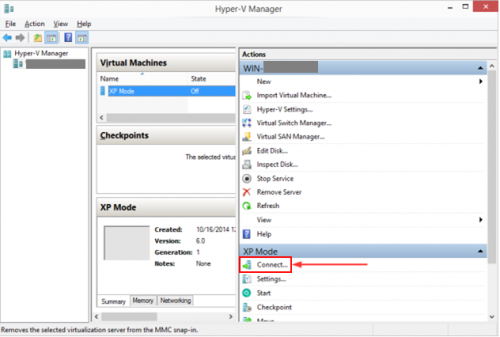
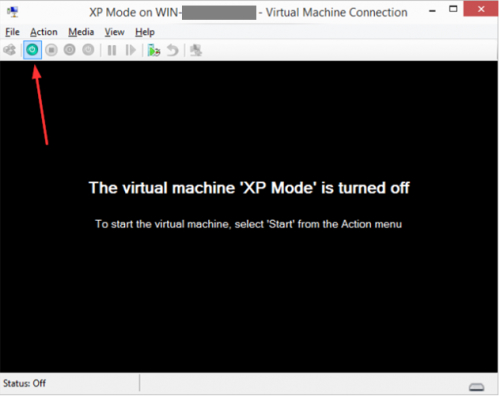
20. The first time you start the VM, it will do the last steps of a regular XP installation. It won’t go through the full XP installation, but you’ll still need to agree to Terms, pick a computer name, set time and date, language and, after a final reboot, it will prompt you to configure updates.

21. If everything went well, you should have a working XP Virtual Machine inside your Windows 8 now.
22. When installation done you will see the Windows XP desktop.
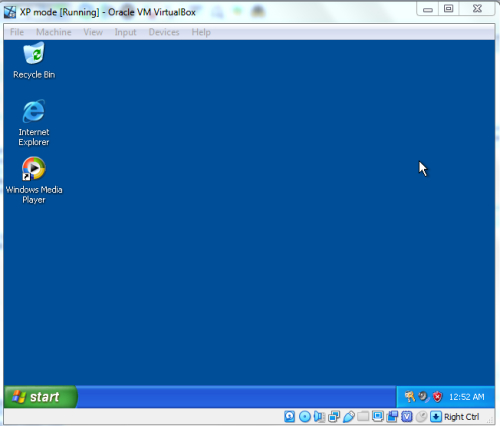
23. Go to Google drive and download the SETS6000.rar with SET6000 program files. The archive file size is 191 MB.
24. Unzip the folder SETS 6000 from SETS6000.rar to your PC. You will find subfolder SETS 6000 inside with three files – SETS6k_Disk1.mdf, SETS6k_Disk1.mds and KEY.txt. In order to mount your disk image use file SETS6k_Disk1.mdf.
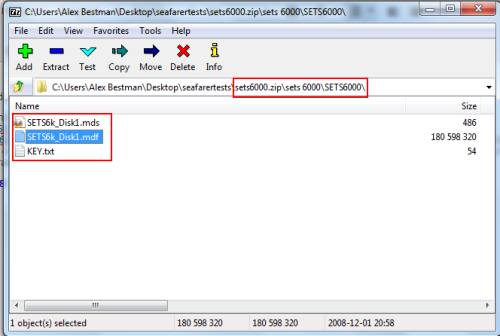
25. Unzip and install UltraISO program. Open UltraISO program, click on Continue to Try button if this program is not registered.
26. Click on Mount to Virtual Drive icon (shown with red arrow).
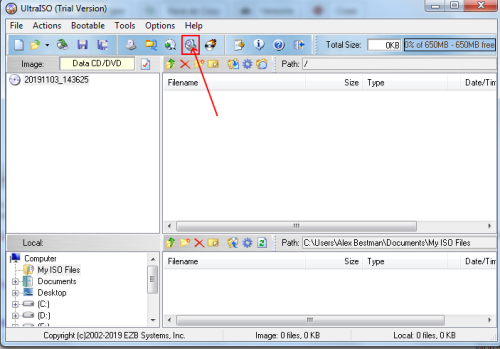
27. Select the image file SETS6k_Disk1.mdf and click on Mount button. If you want to unmount image file from virtual drive click on Unmount button.
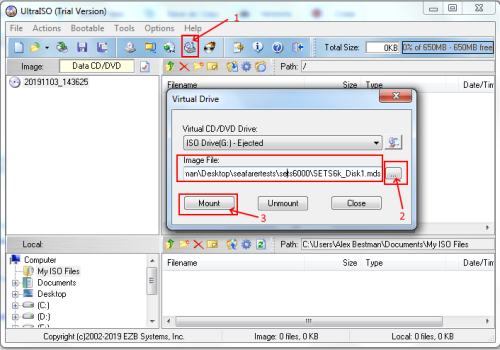
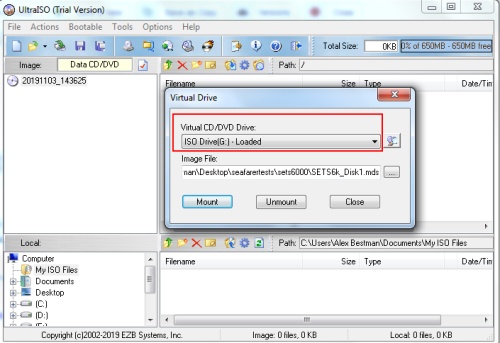
28. Your image file is loaded on Virtual Drive now. As you can see we have the virtual (G) drive with image file.
29. Go to My Computer and you will see the Virtual Drive with SETS6k_Disk1.mdf image.
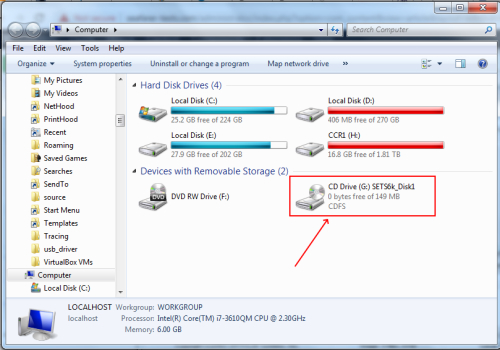
30. Go back to Oracle VM VirtualBox window. Go to Devices -> Optical Drives and make sure that Host drive (G) selected.

31. You will see pop-up window with three grey buttons – SETS 6000 WorkStation , SETS 6000 Reports , SETS 6000 Data Files
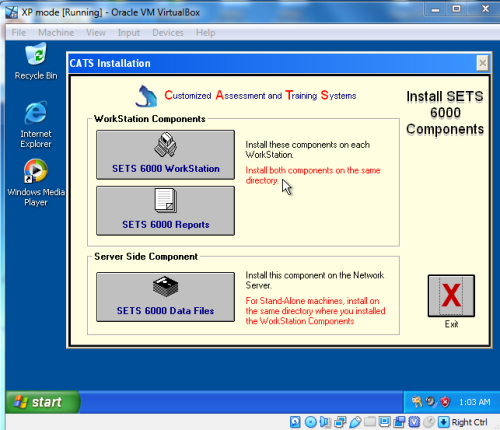
32. Click on SETS 6000 WorkStation button. You will need to click on Next button till the installation starts (5 times). If you will get any errors just agree with them – click on OK button.
33. When the first part has been installed click on SETS 6000 Reports button. You will need to click on Next button till the installation starts (4 times). Then click on Finish button. The second part installation completed.
34. If the system is asking to restart PC click on OK button and restart your PC. After reboot go to virtual drive and double-click on RunCopy.exe to continue with installation.

35. Click on SETS 6000 Data Files button. You will need to click on Next button till the installation starts (5 times). Then click on Finish button. The last part installation completed.
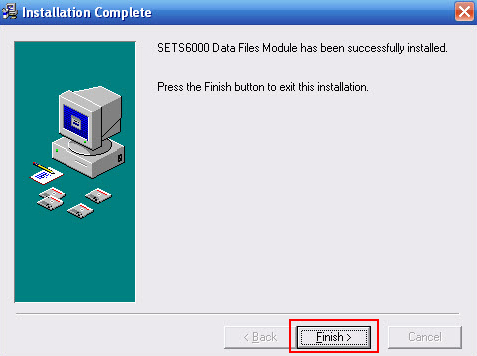
36. Click on Exit button.
37. Find on your desktop SETS6000 shortcut and double-click on it.

38. You will see the Reminder pop-up window with timer of 10 seconds.
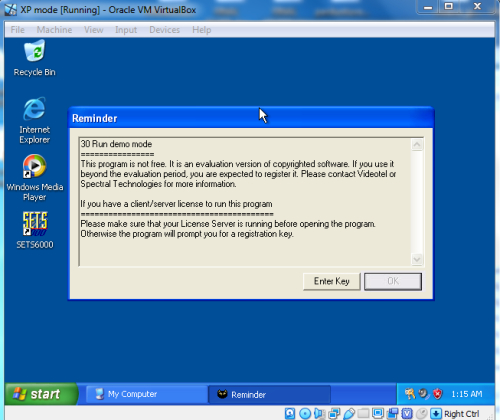
39. Wait untill OK button will be active.
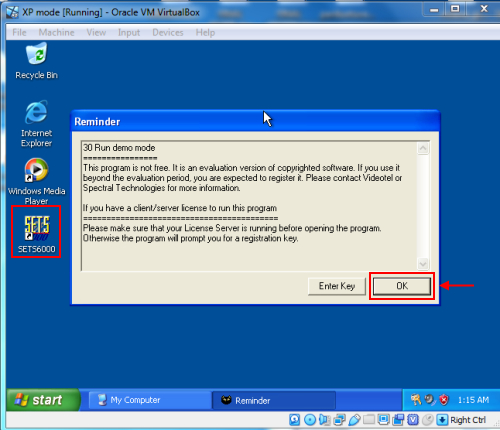
40. Click on OK button and you will see a new pop-up window.
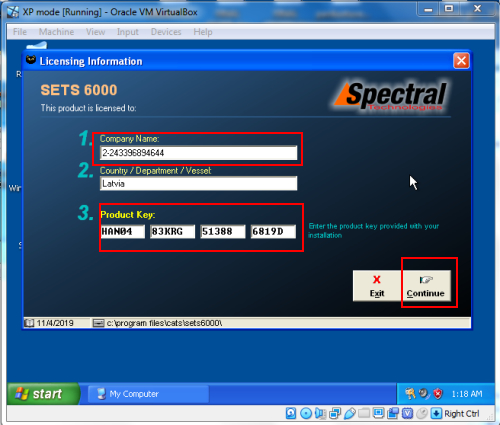
41. Type the company name (2-2403396894644), country / department / vessel (any information) and product key (HAN04-83KRG-51388-6819D)
42. Click on Continue button. You will see pop-up window.
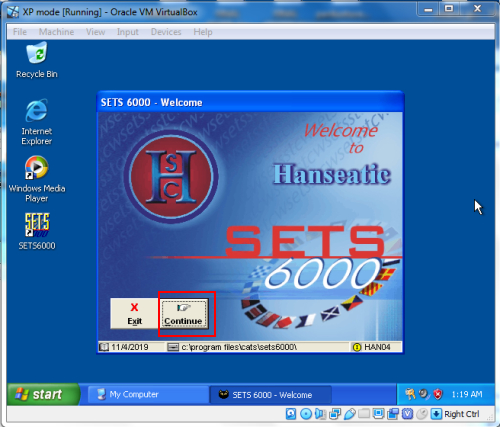
43. Click on Continue button.
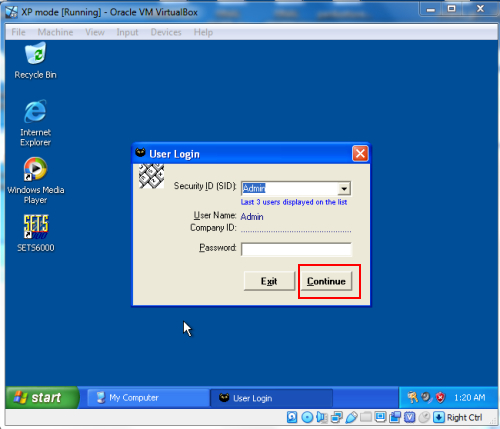
44. You do not need to type the password, just click on Continue button. That’s it. You can access Tutorial tests now.
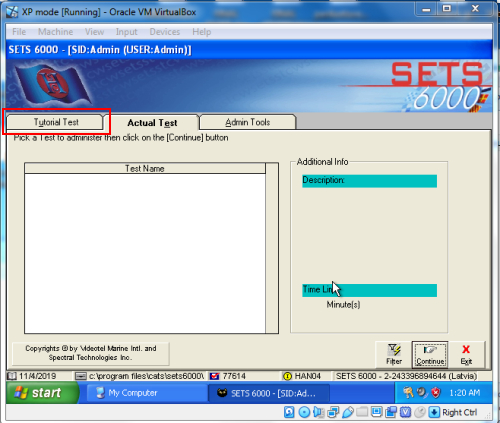

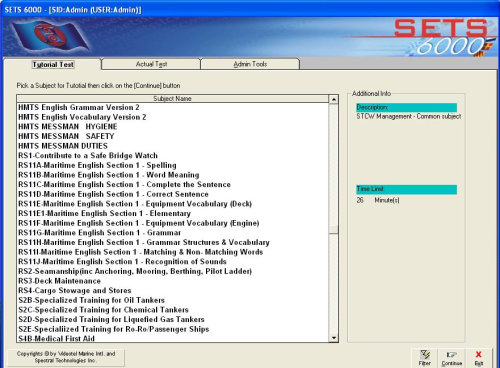
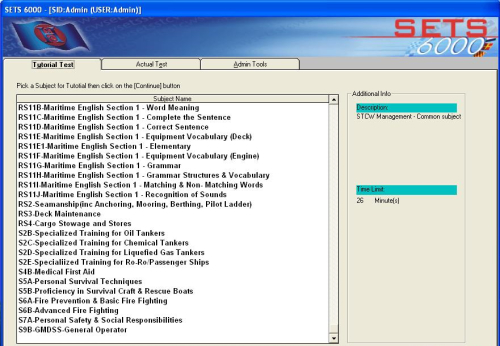
Making the Internet work on the XP Virtual Machine
If the internet connection is not working on your newly created XP Virtual Machine, here’s what you can try:
1. Turn off the XP Virtual Machine.
2. Open its settings window. You can do this in several ways – from the Hyper-V Manager, select the XP Virtual Machine and, in the right hand pane, click on Settings or if the XP VM window is active, you can click on File -> Settings.

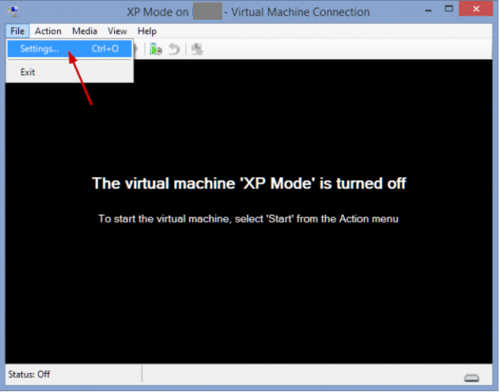
3. In the Settings window, simply Add Hardware -> Legacy Network Adapter. The Add Hardware option is the first one in the Settings window.
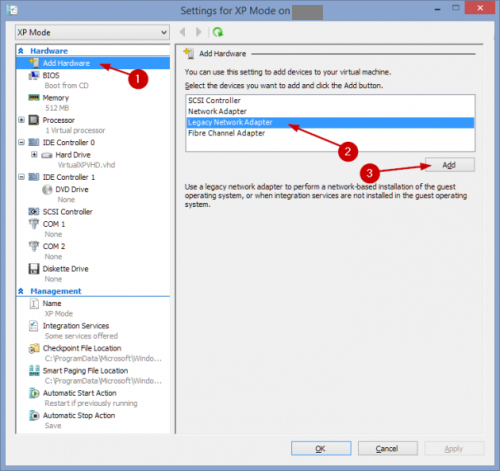
4. Make sure the Legacy Network Adapter is set to use the previously created Virtual Switch (External).

5. Click on Apply, then OK buttons and start the XP VM again. It should result in a quick driver install in the VM and, afterwards, the network should work inside the VM.
